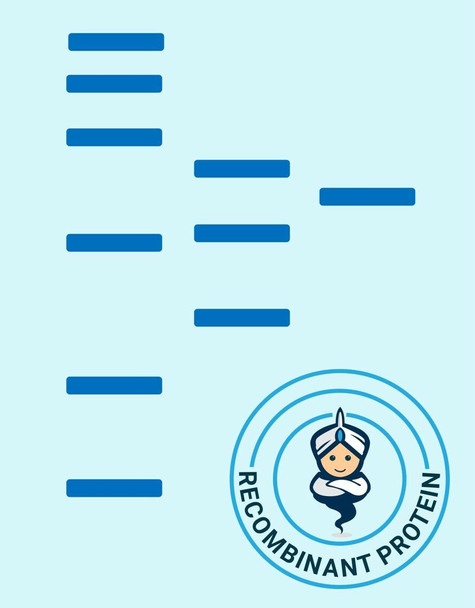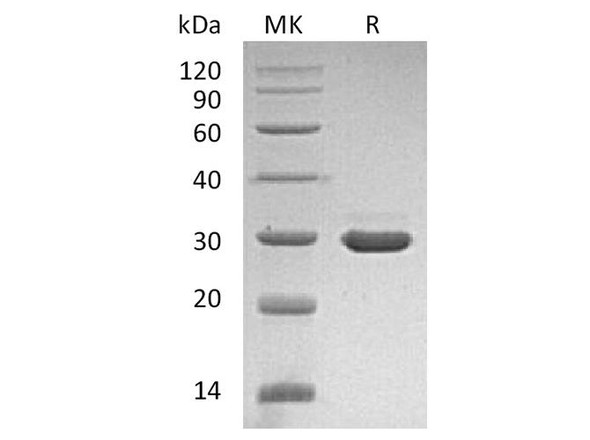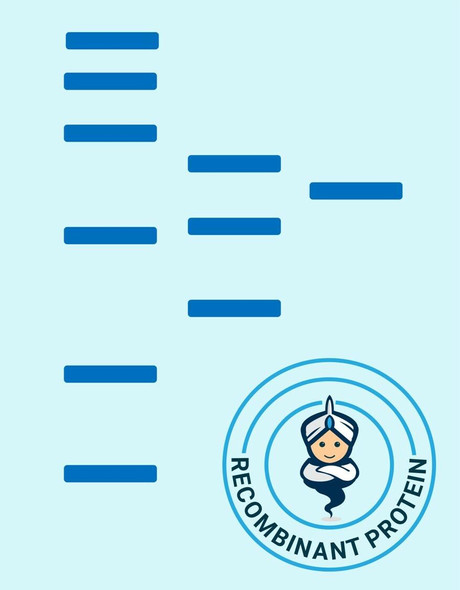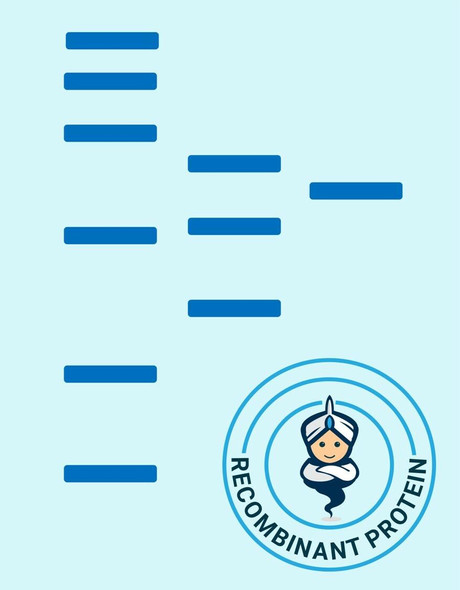Description
| Product Name: | Human b NGF Recombinant Protein |
| Product Code: | RPPB0110 |
| Size: | 20µg |
| Species: | Human |
| Target: | b NGF |
| Synonyms: | Beta Polypeptide, NGF, NGFB, HSAN5, Beta-NGF, MGC161426, MGC161428. |
| Source: | HEK293 Cells |
| Physical Appearance: | Sterile Filtered White lyophilized (freeze-dried) powder. |
| Formulation: | The b-NGF was lyophilized from 1mg/ml in�20mM PB and 0.25M NaCl�pH-7.5. |
| Solubility: | It is recommended to reconstitute the lyophilized b-NGF in sterile�distilled pyrogen free water�at a concentration of 0.25mg/ml. |
| Stability: | Lyophilized b-NGF although stable at room temperature for 3 weeks, should be stored desiccated below -18°C. Upon reconstitution b-NGF should be stored at 4°C between 2-7 days and for future use below -18°C.For long term storage it is recommended to add a carrier protein (0.1% HSA or BSA).Please prevent freeze-thaw cycles. |
| Purity: | Greater than 97% as obsereved by SDS-PAGE. |
| Biological Activity: | The specific activity was determined by the dose-dependent stimulation of the proliferation of human TF-1 cells (human erythroleukemic indicator cell line), the ED50 is <0.04-0.4ng/ml. |
NGF-beta has nerve growth stimulating activity and the complex is involved in the regulation of growth and the differentiation of sympathetic and certain sensory neurons. Mutations in this gene have been associated with hereditary sensory and autonomic neuropathy, type 5 (HSAN5), and dysregulation of this gene's expression is associated with allergic rhinitis.
BNGF�Human Recombinant produced in�HEK293 is a noncovalently disulfide linked homodimer, glycosylated, polypeptide chain (Ser122-Arg239) containing 2 identical 118 amino acids and having a molecular mass of 26.5 kDa.
| UniProt Protein Function: | NGF: Nerve growth factor is important for the development and maintenance of the sympathetic and sensory nervous systems. Extracellular ligand for the NTRK1 and NGFR receptors, activates cellular signaling cascades through those receptor tyrosine kinase to regulate neuronal proliferation, differentiation and survival. Homodimer. Belongs to the NGF-beta family. |
| UniProt Protein Details: | Protein type:Secreted, signal peptide; Secreted Chromosomal Location of Human Ortholog: 1p13.1 Cellular Component: cytoplasmic membrane-bound vesicle; endosome; extracellular region; Golgi lumen Molecular Function:growth factor activity; metalloendopeptidase inhibitor activity; nerve growth factor receptor binding; protein binding; receptor signaling protein activity Biological Process: activation of MAPKK activity; cell-cell signaling; induction of apoptosis via death domain receptors; negative regulation of apoptosis; negative regulation of cell cycle; negative regulation of neuron apoptosis; nerve growth factor processing; nerve growth factor receptor signaling pathway; neurite morphogenesis; neuron apoptosis; peripheral nervous system development; phosphoinositide-mediated signaling; phospholipase C activation; positive regulation of apoptosis; positive regulation of axon extension; positive regulation of axonogenesis; positive regulation of collateral sprouting; positive regulation of neuron maturation; positive regulation of protein ubiquitination; Ras protein signal transduction; regulation of axonogenesis; regulation of caspase activity; regulation of neuron differentiation; regulation of neurotransmitter secretion; regulation of release of sequestered calcium ion into cytosol; sensory perception of pain; small GTPase mediated signal transduction; transmembrane receptor protein tyrosine kinase signaling pathway Disease: Neuropathy, Hereditary Sensory And Autonomic, Type V |
| NCBI Summary: | This gene is a member of the NGF-beta family and encodes a secreted protein which homodimerizes and is incorporated into a larger complex. This protein has nerve growth stimulating activity and the complex is involved in the regulation of growth and the differentiation of sympathetic and certain sensory neurons. Mutations in this gene have been associated with hereditary sensory and autonomic neuropathy, type 5 (HSAN5), and dysregulation of this gene's expression is associated with allergic rhinitis. [provided by RefSeq, Jul 2008] |
| UniProt Code: | P01138 |
| NCBI GenInfo Identifier: | 90110037 |
| NCBI Gene ID: | 4803 |
| NCBI Accession: | P01138.3 |
| UniProt Secondary Accession: | P01138,Q6FHA0, Q96P60, Q9P2Q8, Q9UKL8, A1A4E5, |
| UniProt Related Accession: | P01138 |
| Molecular Weight: | 26,959 Da |
| NCBI Full Name: | Beta-nerve growth factor |
| NCBI Synonym Full Names: | nerve growth factor |
| NCBI Official Symbol: | NGF�� |
| NCBI Official Synonym Symbols: | NGFB; HSAN5; Beta-NGF�� |
| NCBI Protein Information: | beta-nerve growth factor |
| UniProt Protein Name: | Beta-nerve growth factor |
| Protein Family: | Nerve growth factor |
| UniProt Gene Name: | NGF�� |
| UniProt Entry Name: | NGF_HUMAN |








